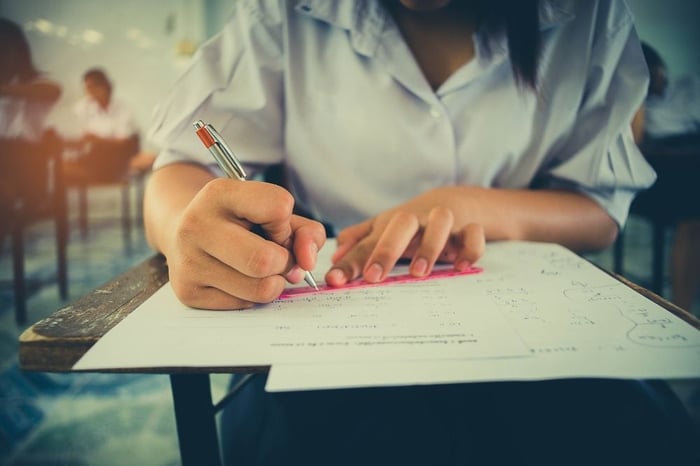
BMAT Section 2 tips
Section 2 of the BMAT assesses applicants' biology, chemistry, physics and maths knowledge. Supposedly, the knowledge required is GCSE level. Students usually fall due to the time pressure of this section - there are 27 questions to answer in 30 minutes. If signing up to the BMAT test, you can access the guide detailing the assumed scientific knowledge, which is essentially your test specification. The exam board is very transparent and there is a lot of information available on the BMAT website.

You may feel that the BMAT is difficult to prepare for. However, section 2 is probably the section where BMAT preparation is the most important. Medical schools using the BMAT as part of their admissions process typically follow traditional courses, where medical students are expected to have a high level of core scientific knowledge.
Biology
This part of the exam covers:
- Cells - structure and function of plant, animal and bacterial cells.
- Movement across membranes - diffusion, osmosis, and the factors affecting these.
- Cell division and sex determination - mitosis, meiosis, asexual and sexual reproduction, sex determination.
- Inheritance - genetics, monohybrid crosses.
- DNA - structure, function, protein synthesis.
- Gene technologies - genetic engineering and stem cells.
- Variation - evolution, natural selection and extinction.
- Enzymes - mechanisms, functions, and factors affecting action.
- Animal physiology - respiration, organ systems, disease, homeostasis and hormones.
- Environment - food chains, populations, interactions, life cycles.
You will notice when doing practice papers that the same types of questions come up again and again. These include topics such as genetics and the circulatory system, where you are often asked to interpret and answer questions on a diagram. Spend a lot of time doing past papers and you’ll find patterns, and discover your weaknesses.

Chemistry
This part of the exam covers:
- Atomic structure
- The periodic table
- Chemical reactions and equations
- Quantitative chemistry - make sure you know your key equations! We recommend coming up with your own formula sheet, as you will likely find there are some formulas that you have forgotten.
- Oxidation, reduction and redox - make sure you know the combining powers of the common elements and feel comfortable balancing equations.
- Chemical bonding, structure, and properties - review basic bonds, like ionic and covalent (nothing too complex)!
- Group properties - familiarise yourself with group 1 (alkali earth metals), group 7 (halogens) and the transition metals.
- Separation techniques - an example question may ask you what order of separation techniques are required to extract a from a sample of ab.
- Acids, bases and salts - make sure you know what is formed in each reaction.
- Rates of reaction - this involves a bit of understanding, but just know what affects reaction rate (temperature, pressure, states, concentration etc).
- Energetics
- Electrolysis - from our experience, a lot of students struggle with these questions. Go over the fundamental principles behind electrolysis if you find that you are struggling too. You may find it useful to look at an old revision guide.
- Carbon/ organic chemistry - ensure you know the general formula for alkenes and alkanes, and that you are comfortable identifying ketones, alcohols, carboxylic acids and aldehydes as well.
- Metals
- Kinetics/Particle theory
- Chemistry tests
- Air and water

Physics
Many students struggle with the physics questions in the exam, as some haven’t done any since GCSE. The questions can be tricky at times, but we find the most common questions that come up focus on electricity, waves, and radioactivity. Nevertheless, the BMAT section 2 assumed subject knowledge guide states that you should be comfortable with the following concepts:
- Electricity - students often struggle with resistance and circuit diagrams.
- Magnetism
- Mechanics
- Thermal physics - conduction, convection, radiation, matter.
- Matter
- Waves - make sure you remember how to draw ray diagrams and understand the concepts of refraction and reflection. A common error here is when calculating for example wave speed and you ignore that the wave has reflected from a surface and thus travelled twice the distance.
- Radioactivity- go over the concepts of nuclear fission and fusion and where they are used. Practise some radioactive decay equations.

Mathematics
The maths questions are generally not too difficult, but the timing can cause some students to struggle. The exam board will occasionally throw a difficult algebraic rearrangement at you which may look quite scary. If you are struggling, look at the answers and see which might be possible. The concepts you are expected to be familiar with are:
- Units
- Number - make sure you can remember how to use surds and pi in calculations.
- Ratio and proportion
- Algebra - you are expected to recognise and interpret graphs for simple cubic, trigonometric and reciprocal functions. The rearrangements can be quite tricky, so be sure to practise some beforehand/ go over the rules.
- Geometry - refresh yourself of some of the circle theorems, geometric proofs and key equations, such as Pythagoras’ theory.
- Statistics - questions will typically involve finding the missing value after being presented with the mean/ median/ mode. Make sure you feel confident drawing conclusions with graphs, especially unfamiliar types.
- Probability - again, these can be tricky. You must be able to evaluate all the possible outcomes and use tree diagrams to solve questions involving combined events. As ever, practise lots of questions.



